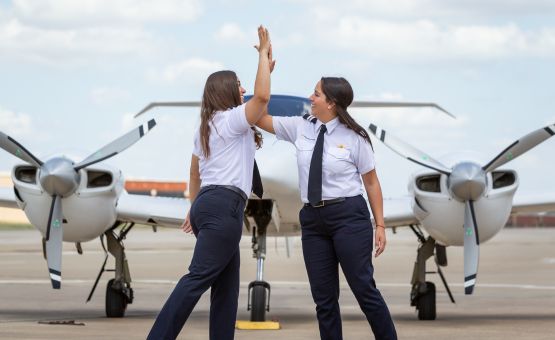By Andrew Henley
Editor’s Note: In this month’s column, Andrew explores the Private Pilot portion of the Career Academy. More information on the career training programs offered by American Flyers can be found by going to https://americanflyers.com/american-flyers-airline-academy/
On the quest to become a commercial pilot, there are many segments. Segment one: the Private Pilot Course. For me, this is one of the most exciting parts of my job because I get to see students experiencing flight for the first time. The excitement, the thrill, the barrage of emotions that they undergo. As a father-to-be living in Florida, I imagine that this will be the same feeling I get when I see the look on my child’s face the first time they see Disney; it’s magical and I thoroughly enjoy the experience through the eyes and expressions of our students.
Remember that private pilot training is the only time we actually teach a student how to fly an airplane, everything else is learning a new set of rules by which to fly. Whether you’re learning to fly a plane, play 18 holes of golf or play the piano, training must be consistent, frequent and it has to be efficient. This is one of the reasons why the private pilot segment of the Commercial Academy is so successful. Students find that the organization and structure of the Commercial Academy streamlines the training process. We build upon each lesson to introduce the next task, reviewing, evaluating and teaching the next maneuver.
This first part of the Commercial Academy, where students become a commercial pilot, consists of a total of 75 hours of education. A portion of this is classroom instruction, which is presented to the whole group in an academy-style setting (hence the name “Commercial Academy”). This brings the group together by drawing on past experiences and building camaraderie.
This is another high-point for me— watching as relationships are created and roles are defined. Everyone has something to contribute and different areas of expertise and so, they all have something to give to the academy.
We’ll get doctors who command the room when it comes to aeromedical factors; avid sailors who provide practical descriptions of how a wing creates lift; air-traffic controllers who educate us all on ground and air operations; and younger aspiring pilots, who just soak it all up like smiling sponges. This is the bulk of the training, and it’s the part where several individuals become one group, all working toward the same goal. Again, it makes my smile bigger and bigger every day.
After class every day and between flights, we’ll find our Academy students gathered around our simulators, as they take what they have learned in the classroom and try it out in our simulations. Learning the maneuvers from the comfort and convenience of our simulators gives them the chance to hone their procedures and familiarize themselves with the cockpit before practicing in the aircraft. This is one of the key components to our learning system; enabling students to practice as much as they need to while minimizing the hours in the airplane. It also gives us the ability to weather-proof our training, as the weather in the simulator bay is always flyable. It’s not always VMC, but the simulator gives us the chance to introduce weather and aircraft-related emergencies from a safe place. It also allows us to fly out of any airport—anyone up for a flight over the picturesque Grand Canyon?
Flying is of course the most fun for the students, but it isn’t what makes the program. In IFR training, we talk about the 6T’s, but in the Academy we talk about the 6Ps: Proper Prior Planning Prevents Poor Performance. The hours spent in the classroom and in the simulators – planning and preparing – are what make this program effective and what enables us to help our students earn their wings in half the time of the national average. It’s the time spent outside of the aircraft that defines the time spent inside the aircraft. If a career flight training student was a sculpture, then at the end of this first stage of training – the private pilot stage – we’ve basically refined the piece of clay or marble to its best possible state. We’re now ready to begin forming the end product. With a private certificate in hand, we’re now ready to start turning each student into a professional pilot. And while these next steps are key to their development and career, the first step is the most important, the most exciting and, again, for me, the most rewarding.










